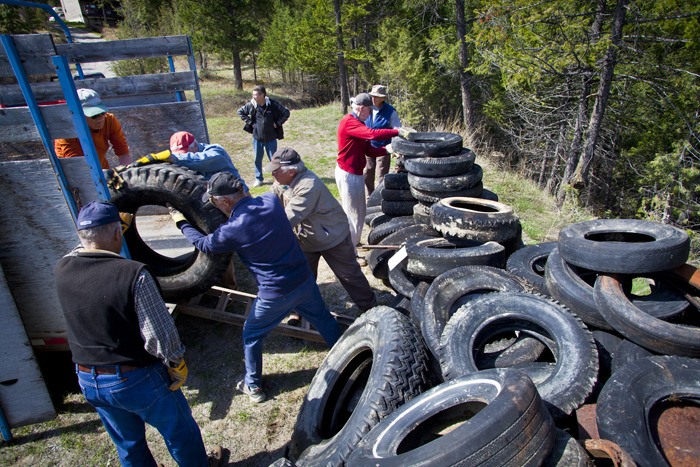The wetlands of Wilmer are becoming wild again with a heap of human help.
On Saturday (April 28), a group of 14 concerned local citizens successfully removed 160 old tires from the Wilmer area of the Columbia River Wetlands as part of Valley Pride cleanup day. The day-long effort was the culmination of a two-year long project initiated by the Invermere branch of the regional environmental group Wildsight.
Long term local resident Jim Galloway, who took part in the clean up, said the undertaking was “exhausting.”
“Some of the tires were so heavy, it took two people to handle them,” Galloway said. “Some of the other tires were still on rims and those were quite heavy and awkward to move.”
The Invermere branch is one of five Wildsight branches located throughout the East Kootenay region, which operate under the non-profit organization’s umbrella mandate to protect and promote biodiversity and healthy communities in the Columbia and Rocky Mountain region. Local branches works on issues specific to their area. The tire dumping site at the Wilmer marsh has been of particular concern to the Invermere branch. It has caused 80 years of degradation to the river, Galloway said.
“Over the years, it became everybody’s favourite dumping zone,” he said. “I’m talking about going back 80 years.”
The Invermere group has orchestrated several Columbia Wetlands cleanup projects over the years, some with assistance from the federal government, which has sent out several professional crews to remove car bodies, engine blocks and heavy scraps of metal, Galloway said.
In the past, people who knew better “but didn’t give a damn” would dispose of their unwanted automobile by putting it into neutral and pushing it off a cliff, he said.
Galloway estimates most of the tires removed from the Wilmer wetlands on Saturday were anywhere between thirty and fifty years old.
“We didn’t see any tires that looked new,” he said.
Many of the tires had sunk deep down into the shoreline. After removing them from the mud and water, volunteers loaded the tires onto waiting pickup trucks, transported them up a steep climb to a higher staging area, then transferred them onto a large pickup and trailer, bringing them to the Columbia Valley landfill for storage until collected for recycling. Volunteers used their own vehicles.
“It was so labourious,” said Galloway, adding the tire removal work was so exhausting and dirty that it’s taken the group two years’ worth of monthly efforts to pile up the 160 tires, which were skidded across the ice during the winter months, at the Wilmer site.
